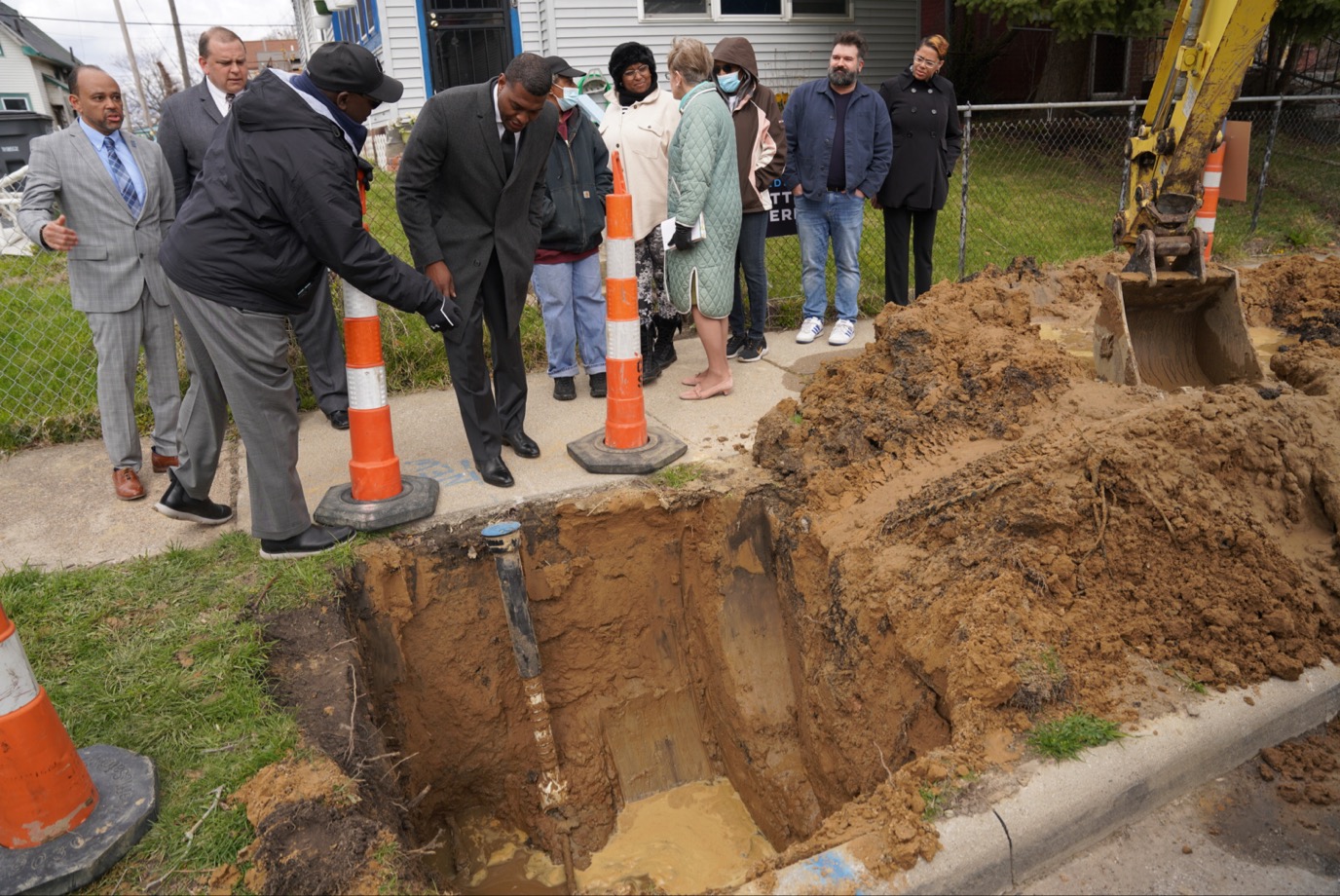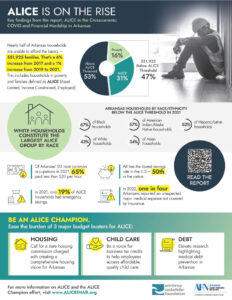
Following his Journey to Justice Tour in late 2021, US Environmental Protection Agency Administrator Michael S. Regan (center) has responded with a series of actions responding directly to concerns of communities historically and disproportionately impacted by pollution.
Funding is part of nearly $4 billion in infrastructure bounty for Arkansas under the Biden administration’s Bipartisan Infrastructure Law
Arkansas Delta Informer Executive Editor Wesley Brown – May 16, 2022 – The U.S. Environmentally Protection Agency on Monday announced the availability of $1.9 billion in grant funding to the State Revolving Funds (SRF) to accelerate progress on water infrastructure projects.
Combined with historic investments of nearly $60 billion through the $1.2 trillion Bipartisan Infrastructure Law, EPA Administrator Michael Regan said in a letter to governors in all 50 states funding will help states, Tribes, and territories upgrade water infrastructure to provide safe drinking water, protect vital water resources, and create thousands of new jobs in communities across the country.
“The law’s investment in water is nothing short of transformational. It includes $50 billion to the EPA to strengthen the nation’s drinking water and wastewater systems – the single largest investment in water that the federal government has ever made,” said Regan. “I write to share my commitment to forging a productive partnership between the EPA and the states to maximize the impact of these funds in addressing urgent water challenges facing communities.”
Under the allocation formula that hands all the new federal funding to all 50 states, Arkansas’ first round of funding for a slice of the federal SRF pie is more than $93.2 million. In his letter to the governors, including Arkansas Gov. Asa Hutchinson, Regan urges states to initiate planning for the use of these funds, specifically targeting communities who are disproportionately impacted by lead in drinking water.
Regan said many rural and unserved communities in many states are grappling with emerging contaminants, such as PFAS which are widely used, long-lasting chemicals that break down very slowly over time.
“For far too long, families across America – especially those in underserved communities – have suffered from PFAS in their water, their air, or in the land their children play on,” said Regan. “This comprehensive, national PFAS strategy will deliver protections to people who are hurting, by advancing bold and concrete actions that address the full lifecycle of these chemicals. Let there be no doubt that EPA is listening, we have your back, and we are laser-focused on protecting people from pollution and holding polluters accountable.”
Regan also said every level of government – from local, to state, to Tribal, to federal will need to exercise increased and sustained leadership to continue the momentum and make progress on PFAS. In late 2021, Regan completed a “Journey to Justice” tour across the American South where he heard from families and advocates about their struggles with exposure to water pollution in their communities.
For children, exposure to lead can cause irreversible and life-long health effects, including decreasing IQ, focus, and academic achievement, said Regan. At the same time, he said families that live near high levels of contaminants such as PFAS or “forever chemicals” are at risk to develop adverse health outcomes.
Following his nationwide tour, the EPA first announced the agency’s PFAS Strategic Roadmap – laying out a whole-of agency approach to addressing PFAS. The roadmap sets timelines for specific actions by the EPA and commits us to bolder new policies to safeguard public health, protect the environment, and to hold polluters accountable.
The Bipartisan Infrastructure Law provides $10 billion to start systematically reducing the risk that people will be exposed to PFAS and other contaminants through their drinking water and to help address discharges through wastewater. Half of these funds will go through the SRFs, said Regan.
In 2022, EPA is providing approximately $3.2 billion to the Clean Water SRFs, including $1.2 billion in new base federal grant funding being announced today and $2 billion through the Bipartisan Infrastructure Law. This total investment represents a near doubling of annual investment in the Clean Water SRF to support a wide range of water infrastructure projects, including modernizing aging wastewater infrastructure, implementing water reuse and recycling, and addressing stormwater. More than $47 million in direct grant funding is available to Tribes, certain U.S. territories, and the District of Columbia for infrastructure projects.
EPA is also providing $6.4 billion to the Drinking Water SRFs, including $728 million in new base federal grant funding announced today and $5.7 billion through the Bipartisan Infrastructure Law. This total investment represents a six-fold increase in annual investment to help drinking water systems remove lead service lines, install treatment for contaminants, and improve system resiliency to natural disasters such as floods. More than $32 million in direct grant funding is available to Tribes, certain U.S. territories, and the District of Columbia to use for drinking water system upgrades.
“Our nation’s water infrastructure is in significant need of upgrades to support communities that rely on it day-in and day-out. With this funding provided through annual appropriations, coupled with investments under the Bipartisan Infrastructure Law, EPA is providing $9.6 billion in the SRFs to deliver the benefits of water infrastructure investments to more communities—especially those that have long been overburdened by water challenges,” said EPA Assistant Administrator for Water Radhika Fox.
Signed into law by President Biden on Nov. 15, the White House and other trade groups have released details that estimate Arkansas’ piece of the infrastructure bill pie to build new bridges, roads, water infrastructure projects, and broadband networks will be as high as $4 billion.
According to the American Society of Civil Engineers (ASCE), the infrastructure bill represents a historic, once-in-a-generation investment in our roads, bridges, water and wastewater networks, ports, electric grid, dams, and more. In addition to increasing funding to all 50 states, the huge spending plan also makes smart improvements to policy such as streamlining permitting and creating new programs targeted at almost all 17 categories in the 2021 Report Card for America’s Infrastructure.
“The bill is a significant down payment on the $2.5 trillion infrastructure investment gap that was identified in the 2021 Report Card and will benefit American businesses and families for years to come,” ASCE said in the statement.
While the nation’s infrastructure earned a C- grade in the 2021 Infrastructure Report Card, Arkansas faces infrastructure challenges of its own. For example, the annual report card shows that driving on roads in need of repair in Arkansas costs each driver $671 per year, 4.9% of bridges are rated structurally deficient, and drinking water needs in Arkansas are an estimated $7.4 billion.
Also, the highly watched report card shows that 193 dams in the Natural State are high-hazard potential, while the state’s schools have an estimated capital expenditure gap of $350 million. Overall, the ASCE assigned Arkansas an overall grade of C, noting that Arkansas has the nation’s 12-largest highway system with 31% of the state’s roads in disrepair.
“This deteriorating infrastructure impedes Arkansas’s ability to compete in an increasingly global marketplace. Success in a 21st-century economy requires serious, sustained leadership on infrastructure investment at all levels of government,” stated ASCE. “Delaying these investments only escalates the cost and risks of an aging infrastructure system, an option that the country, Arkansas, and families can no longer afford.”
Closer to home, the Walton-family Heartland Family think tank highlighted $65 billion in new broadband investments, especially in rural areas that are lacking internet infrastructure. At the behest of Gov. Asa Hutchinson, the Bentonville-based think tank July 7 published a new report that offers guidance to Arkansas policymakers seeking to bolster the state’s economic rebound and growth as it recovers from the COVID-19 pandemic.
In the 77-page report, called the “Arkansas Economic Recovery Strategy,” Heartland Forward analyzed comprehensive data across six key economic areas commissioned by the Arkansas Economic Recovery Task Force. Of note, the study concluded that Arkansas was hard hit by the pandemic in unique ways, including the urban-rural digital divide where 35% of households have no access to the internet.
“(The) historic passage of the federal infrastructure package is welcome news in the fight to close the digital divide across the heartland. Containing billions of dollars in funding to expand internet access across the country, this legislation holds great promise to improve life for everyday Americans — especially the estimated 40 million Americans who still lack access to the reliable, affordable high-speed internet needed to participate fully in our digital age,” said Angie Cooper, chief program officer for the Arkansas research group. “Now the real work begins to make sure every dollar is spent efficiently and supports the communities it’s intended to help. Heartland Forward is eager to continue our work with policymakers and community groups as we help get this unprecedented funding to heartland residents.”
Meanwhile, the White House released a fact sheet in August detailing that Arkansas would expect to receive nearly $3.6 billion for federal-aid highway apportioned programs and $278 million for bridge replacement and repairs under the new legislation over the next five years.
In addition, Arkansas can also compete for the $12.5 billion Bridge Investment Program for economically significant bridges and nearly $16 billion of national funding in the bill dedicated to major projects that will deliver substantial economic benefits to communities.
Based on current day projects, the Biden administration released the following numbers concerning the state’s portion of the federal appropriations. Specifically, the Infrastructure Investment and Jobs Act will:
• Build a network of EV chargers to facilitate long-distance travel and provide convenient charging options. Arkansas would expect to receive $54 million over five years to support the expansion of an EV charging network in the state. Arkansas will also have the chance to apply for the $2.5 billion in grant funding dedicated to EV charging in the bill.
• Help connect every American to reliable high-speed internet. Arkansas will receive a minimum allocation of $100 million to help provide broadband coverage across the state, including providing access to the at least 461,000 Arkansans who currently lack it. Also, 980,000 or 34% of people in Arkansas will be eligible for the Affordability Connectivity Benefit, which will help low-income families afford internet access.
• Prepare more of our infrastructure for the impacts of climate change, cyberattacks, and extreme weather events. Arkansas will expect to receive $23 million over five years to protect against wildfires and $16 million to protect against cyberattacks. Arkansans will also benefit from the bill’s historic $3.5 billion national investment in weatherization which will reduce energy costs for families.
• Deliver clean drinking water to every American and eliminate the nation’s lead service lines and pipes. Based on the traditional state revolving fund formula, Arkansas will expect to receive $528 million over five years to improve water infrastructure across the state and ensure that clean, safe drinking water is a right in all communities.
• Improve our nation’s airports. Local airports in Arkansas would receive approximately $117 million for infrastructure development for airports.
#30#



 Sign up as a free Arkansas Delta Informer digital subscriber and get breaking news and weekly news roundup in your inbox.
Sign up as a free Arkansas Delta Informer digital subscriber and get breaking news and weekly news roundup in your inbox.